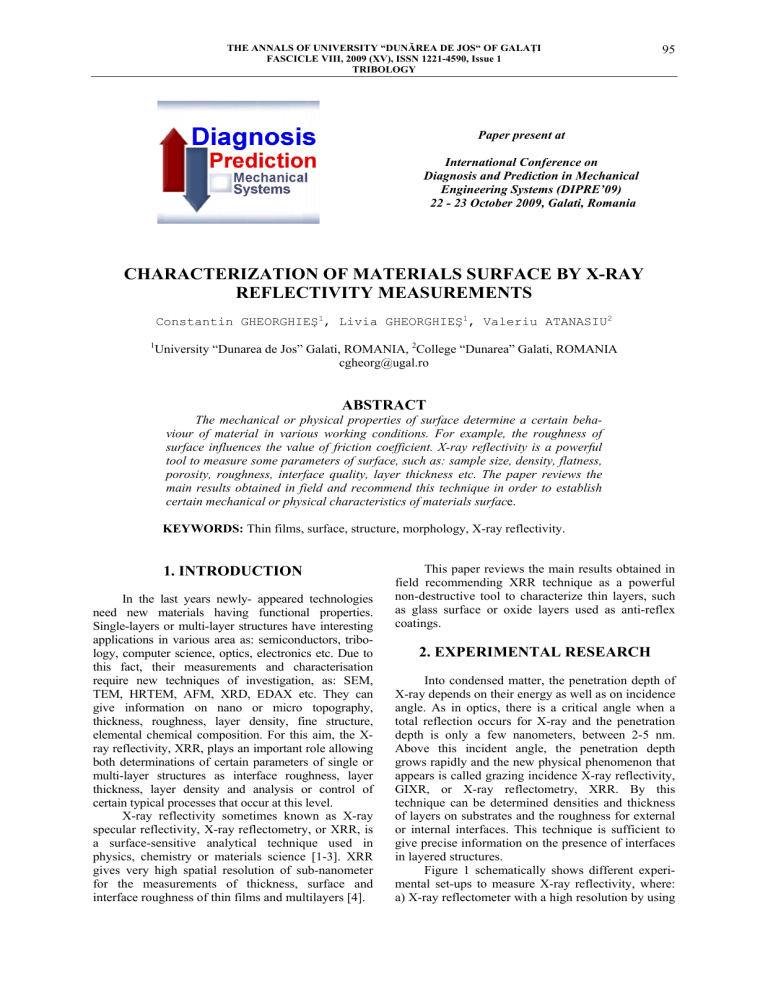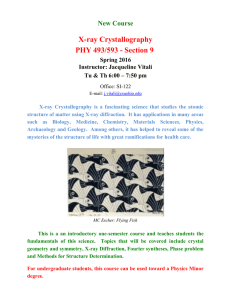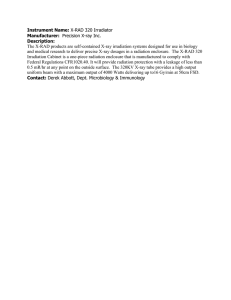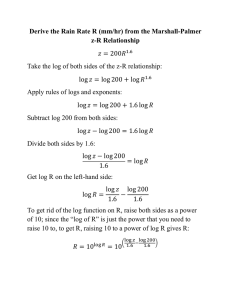characterization of materials surface by x

THE ANNALS OF UNIVERSITY “DUN Ă REA DE JOS“ OF GALA Ţ I
FASCICLE VIII, 2009 (XV), ISSN 1221-4590, Issue 1
TRIBOLOGY
95
Paper present at
International Conference on
Diagnosis and Prediction in Mechanical
Engineering Systems (DIPRE’09)
22 - 23 October 2009, Galati, Romania
CHARACTERIZATION OF MATERIALS SURFACE BY X-RAY
REFLECTIVITY MEASUREMENTS
Constantin GHEORGHIE Ş 1 , Livia GHEORGHIE Ş 1 , Valeriu ATANASIU 2
1 University “Dunarea de Jos” Galati, ROMANIA, 2 College “Dunarea” Galati, ROMANIA cgheorg@ugal.ro
ABSTRACT
The mechanical or physical properties of surface determine a certain behaviour of material in various working conditions. For example, the roughness of surface influences the value of friction coefficient. X-ray reflectivity is a powerful tool to measure some parameters of surface, such as: sample size, density, flatness, porosity, roughness, interface quality, layer thickness etc. The paper reviews the main results obtained in field and recommend this technique in order to establish certain mechanical or physical characteristics of materials surfac e.
KEYWORDS: Thin films, surface, structure, morphology, X-ray reflectivity.
1. INTRODUCTION
In the last years newly- appeared technologies need new materials having functional properties.
Single-layers or multi-layer structures have interesting applications in various area as: semiconductors, tribology, computer science, optics, electronics etc. Due to this fact, their measurements and characterisation require new techniques of investigation, as: SEM,
TEM, HRTEM, AFM, XRD, EDAX etc. They can give information on nano or micro topography, thickness, roughness, layer density, fine structure, elemental chemical composition. For this aim, the Xray reflectivity, XRR, plays an important role allowing both determinations of certain parameters of single or multi-layer structures as interface roughness, layer thickness, layer density and analysis or control of certain typical processes that occur at this level.
X-ray reflectivity sometimes known as X-ray specular reflectivity, X-ray reflectometry, or XRR, is a surface-sensitive analytical technique used in physics, chemistry or materials science [1-3]. XRR gives very high spatial resolution of sub-nanometer for the measurements of thickness, surface and interface roughness of thin films and multilayers [4].
This paper reviews the main results obtained in field recommending XRR technique as a powerful non-destructive tool to characterize thin layers, such as glass surface or oxide layers used as anti-reflex coatings.
2. EXPERIMENTAL RESEARCH
Into condensed matter, the penetration depth of
X-ray depends on their energy as well as on incidence angle. As in optics, there is a critical angle when a total reflection occurs for X-ray and the penetration depth is only a few nanometers, between 2-5 nm.
Above this incident angle, the penetration depth grows rapidly and the new physical phenomenon that appears is called grazing incidence X-ray reflectivity,
GIXR, or X-ray reflectometry, XRR. By this technique can be determined densities and thickness of layers on substrates and the roughness for external or internal interfaces. This technique is sufficient to give precise information on the presence of interfaces in layered structures.
Figure 1 schematically shows different experimental set-ups to measure X-ray reflectivity, where: a) X-ray reflectometer with a high resolution by using
96 THE ANNALS OF UNIVERSITY “DUN Ă REA DE JOS“ OF GALA Ţ I
FASCICLE VIII, 2009 (XV), ISSN 1221-4590, Issue 1
TRIBOLOGY four monochromators; b) X-ray reflectometer that may combine measurement reflectivity and X-ray fluorescence; c) X-ray reflectometer with curved graphite monochromator [5]. The X-ray source is a tube with copper or other metal anode and the experiments can be performed by using the parameters: U = 40 kV and I = 40 mA. In addition, the X-ray reflectometer is equipped with a programmable divergence slit so the incident beam can be closed to a small opening that correspond to a beam width of less than 0.02
o for θ . In this way, it is possible to obtain an accurate calibration of the 2 θ zero position and an accurate adjustment of the sample with respect to the incident beam. The alignment of system should be done with an accuracy pf approximately 0.001º in order to determine the critical angle θ c
within a few thousands of a degree.
An additional curved monochromator in front of the detector is mounted that limits the detected wavelength range and 0.04 rad Soller slits are used for limitation of axial divergence.
Figure 3 presents a typical reflectivity measurement represented by a relative complicate curve that can be separated into several domains, corresponding to a certain characteristics of the investigated surface.
Fig. 1. Experimental set-ups for an X-ray reflectometer.
Figure 2 presents typical curves concerning reflectivity measurements in case of a bulk material and in case of a layer deposited on a substrate. It can be seen significant differences between the two cases; there are a first criterion in distinguishing a smooth surface of a rough surface as well as in detection if there is a bulk material or layered material.
Fig. 2 Typical curves of X-ray reflectance.
Fig. 3. Reflectivity curve and its domains.
The letters from the image select certain domains characteristic of the curve that presents the dependence of logarithm reflectivity versus incidence angle [6], namely:
A is a angular plateau and can be used in order to appreciate either certain characteristics of the sample, such as size or flatness either certain properties of instrument used for X-ray reflected measurements, i.e. beam size;
B is a critical angular point that can give information on electron density and knowing the stoichiometric composition, the mass density of the investigated material can be derived. The critical angle depends on the type of X-ray used, namely wavelength and type of investigated material. Thus, in the case of Cu K α radiation, the critical angle is:
0.22° for silicon, 0.42° for nickel, and 0.57° for gold when the layer is deposited on a glass plate;
C is a domain where there are a lot of oscillations in amplitude of reflectivity that can be connected to interference of partially reflected X-ray beams from different depths within the sample and correspond to some changes in the electron density and therefore the spacing of the oscillations contains information on layer thickness;
D is a domain where the values of reflectivity oscillations amplitudes are determined by surface and interface roughness, as well as by density fluctuations and by the resolution of the instrument. Therefore from D domain information on surface roughness or interface roughness and quality in case of multilayers deposited on a support can be obtained;
E is a domain that can be directly correlated to roughness of the surface;
F is a domain of the reflectivity curve associated to the background instrument.
An analysis of the reflectivity curve by means of typical software is very important for thin film production as well as for thin film processing research.
THE ANNALS OF UNIVERSITY “DUN Ă REA DE JOS“ OF GALA Ţ I
FASCICLE VIII, 2009 (XV), ISSN 1221-4590, Issue 1
TRIBOLOGY
This software simulates and/or fits experimental data.
It requires the user input of estimates about the instrumental resolution and sample parameters. Estimates about the coating (number of layers), layer thickness, interface roughness and information about the composition and densities are used as a starting point for the simulation. Start values for the layer thicknesses can be obtained by a Fourier transformation of the experimental curve [7]. The estimated parameters are used to calculate a simulated reflectivity curve which is then graphically compared with the collected data. The simulation process can be continued by either manually changing the sample parameters or by an automated fit process, which uses the simplex-algorithm and simulated thermal annealing methods.
3. RESULTS AND DISCUSSIONS
In this section some examples concerning the use of X-ray reflectivity technique as well as interpret-tation of reflectivity curves are presented.
Figure 4 presents the reflectivity curves obtained from two kinds of titania thin layer having a thickness of 70 nm deposited on a borosilicate glass.
The curve above describes the X-ray reflectivity of titania layer obtained by ion plating (IP) process, while the curve down shows the X-ray reflectivity of titania layer prepared by reactive ion plating (RIP) technique.
Fig. 4. X-ray reflectivity of titania thin films deposited on glass support by two techniques.
Moreover, the X-ray curves show that titania prepared by ion plating process has a much higher density than titania obtained by reactive ion plating process. In the first case the density is of 3.8 g/cm 3 and in the second case it is of 3.1 g/cm 3 . In addition, the difference between surface roughness of titania layers prepared by the two techniques can be seen by analysing the shape of the X-ray reflectivity curves.
The small oscillation amplitude displays a smoother surface in the case of titania prepared by ion plating process it being of 0.5 nm, while in the second it is of
1.0 nm.
Figure 5 shows X-ray reflectometry data for three TaN thin films having various density and thickness. In the so-called rapid XRR technique [9-
11], the measurement times ranged within l…2 minutes.
Fig.5 X-ray reflectivity from TaN thin films.
97
The densities for these films, which are related to the critical angle, can be extracted from the data collected during the first 10 seconds, but thickness data collection needs a longer measurement time, namely 5…6 minutes. Top curve described the X-ray reflectivity of a TaN thin film having a thickness of
70 Å and a density of 13.5 g/cm 3 . Middle and down curves are for the same type of thin film of 80 Å thickness and density of 12.0 g/cm 3 and, 100 Å with density of 8.0 g/cm 3 .
4. CONCLUSIONS
In materials science, X-rays are utilised onto wide varieties of techniques and methods. Some of them are:
X-ray diffractometry (XRD), X-ray fluorescence (XRF), X-ray reflectometry (XRR), grazing incidence small angle X-ray scattering (GISAXS), small angle scattering (SAS) giving information on fine structure, chemical composition and morphology
(sizes, shape, repartition, roughness, electronic density etc.) of the samples that are connected to several properties (mechanical, metallurgical, physic-cal or chemical) of materials. The length-scale probed of these techniques varies from a few tenth of nm up to micrometers.
The XRR technique, presented in this paper, is devoted to analyze some mechanical properties of the thin layers deposited on a substrate and by exposed examples it is shown its capacity to be a powerful tool of investigation in the materials sciences. For thin films having a thickness in the range of 100Å to
2500Å, glancing incidence analyses should be used, and the lower detection limit is strongly influenced of
98 THE ANNALS OF UNIVERSITY “DUN Ă REA DE JOS“ OF GALA Ţ I
FASCICLE VIII, 2009 (XV), ISSN 1221-4590, Issue 1
TRIBOLOGY the film chemistry. In the case when the films have a high degree of texture (such as an epitaxial film), the
XRR technique is not suitable.
REFERENCES
1. Holy V., Kubena J., Ohlidal I., Lischka K ., Plotz, W ., 1993,
X-ray reflection from rough layered systems, Phys. Rev. B , vol. 47,
23, pp. 15896-15903.
2. Jens Als-Nielsen , 2001, Elements of Modern X-ray Physics,
Wiley, New York.
3. Daillant J., Gibaud A . (Eds), 2009, X-ray and Neutron
Reflectivity, Principles and Applications, Springer, Series: Lecture
Notes in Physics , vol. 770.
4. Kojima I ., Li B ., 1999, Structural characterization of thin films by X-ray reflectivity, The Rigaku Journal , vol. 16, no. 2, pp.31-41.
5. Poltz W. M ., Lischka K ., 1994, Characterization of thin films and multilayers by specular X-ray reflectivity, J. Phys . III, vol.4,
Issue 9, pp. 1503-1511.
6. Xia W., Minch B. A., Carducci M. D ., Armstrong N. R ., LB
Films of Rodlike Phthalocyanine Aggregates: Specular X-ray
Reflectivity Studies of the Effect of Interface Modification on
Coherence and Microstructure, Langmuir , 20 (19), pp. 7998–8005.
7. Bridou F., Gautier J., Delmotte F., Ravet M.-F., Durand O .,
Modreanu M., 2006, Thin multilayers characterization by grazing
X-ray reflectometry and use of Fourier transform, App. Surf. Sci ., vol. 253, issue 1, pp. 12-16.
8. Ohta J., Fujioka H., Takahashi H ., Oshima M ., 2002, Characterization of hetero-interfaces between group III nitrides formed by PLD and various substrates, App. Surf. Sci . Vol.190, 1-4, pp.352–355.
9 Agnihotri D. K., Ortega R., 2001, Applications of Fast X- ray
Reflectometry – a Tool for in–situ Thin Film Analysis, Adv. in Xray Analysis , vol. 44, pp. 302-307.
10. Gheorghie ş C., Analiza Structurii Fine a Materialelor, 2007,
Ed. CERMI, Iasi (in Romanian).
11. *** XRD Application Note, 2008, PANalytical Company.



